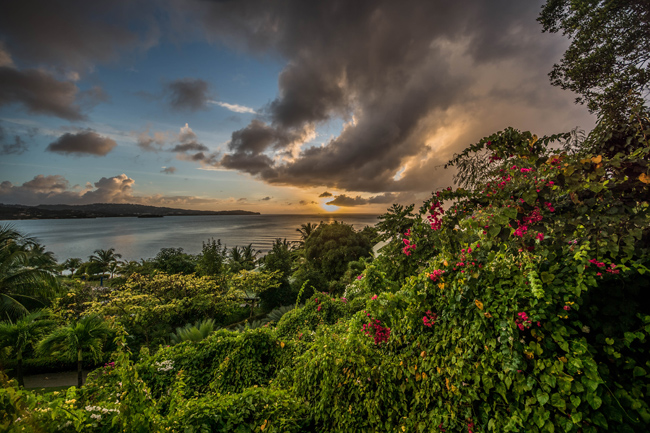
It took 12 hours to get to St. Lucia from San Francisco — five hours to New York, plus a two-hour layover, then five more hours to the island. Which is one of the southeastern most countries in the Caribbean island chain, just north of Trinidad and Tobago, slightly northwest of Barbados, and fairly close to the old Spanish Main (ie, South America) — due north of present-day Guyana. Beyond the general vicinity, I couldn’t have told you much about it before I landed, other than it seemed like the kind of place you’d hear about in a Beach Boys or Jimmy Buffet song, a place where rum-soaked expats go to collect mosquito bites.
I was almost immediately disabused of those notions simply by the natural beauty on the two-hour drive from the airport (surprisingly long for an island that’s only 27 miles by 15, though I’m told the same trip only takes 12 minutes by helicopter). As the two-lane road wound through rainforests and mountainous terrain, it looked more like Hawaii or the misty jungle scenes from Jurassic Park than whatever my barely-formed conception of the Caribbean had been (flat, scrubby, humid — though St. Lucia is pretty humid).
As we wound through jungle, mountains, bays, and several traffic-influenced detours, passing all manner of what looked like beach cottages, with signs advertising incongruous businesses — “NJ’s Spare Parts,” “All American Windows,” “Plastics Repair,” and my favorite, a tiny hut reading “Paul’s Free Wifi” — my driver, Otto, asked me if I knew why St. Lucia was “the only woman island” in the Caribbean.
“Uh… because it’s the only one named after a woman?” I tried. It was a wild guess, and I wasn’t convinced myself, as even nearby Dominica and Martinique sound a little feminine. It turns out I was right though. St. Lucia is the only country in the world named after a woman (Saint Lucy), unless you count Ireland, named for the fertility goddess Ériu.
“Because it’s the only one with twin Pitons,” Otto smiled, pantomiming breasts.
Ahh, yes, the titty mountains (Gros Piton and Petit Piton). The “looks like boobs” game never gets old, as I know from driving past the San Onofre Boobs (as seen in The Naked Gun) countless times during my formative teen years.
In this case, the idea really starts to fall apart if you break it down. “Teton” is the more classic boob-based French word for mountains, as in the Grand Tetons. “Piton” seems to be a word for a spire, a peg, a spike. In other words… a dick. If we’re getting technical, St. Lucia is more like the only two-dicked lady island in the Caribbean, and isn’t that a much more interesting selling point?
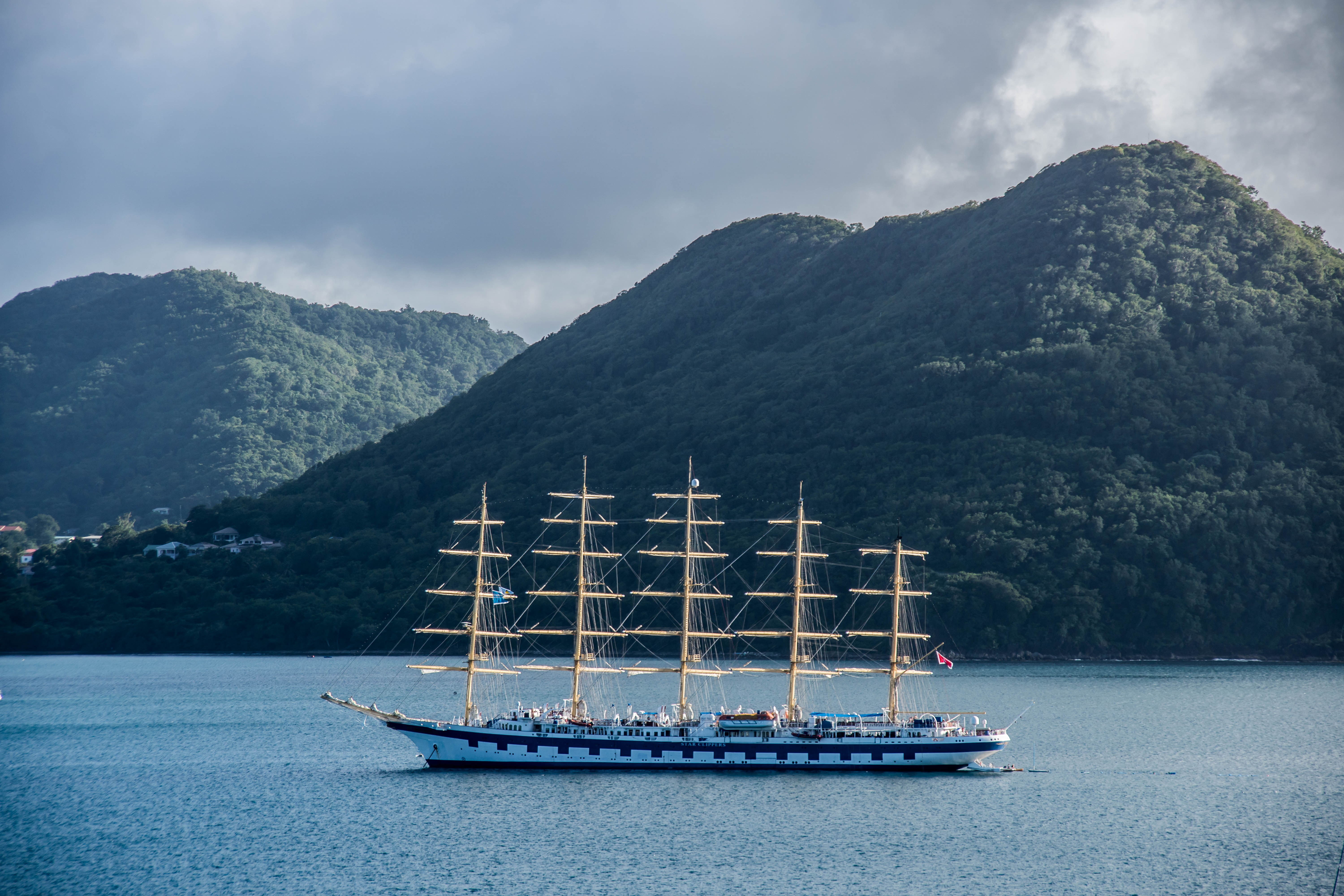
From the airport in Vieux Fort at the southernmost tip of the island, we wound our way up the rainy southwest coast, through rainforests, and up to the sunnier northeastern coast of the island, passing through four or five different climates along the way. I saw nothing but rain in the forecast so I packed a jacket and rain shoes, which was unnecessary — it tends to rain for 10 minutes and then the sun comes out again, five times a day. There are lots of rainbows.
In Castries, a tightly-packed port town with the biggest church in the Caribbean — the Basilica at Derek Walcott Square, framed by picturesque trees with dangling creepers — we passed groups of schoolkids in colorful uniforms just released for the weekend. Later we swerved our way down a mountain switchback before emerging into sun-drenched Rodney Bay, with two massive cruise ships sitting at anchor towering over the town.
St. Lucia’s roads are narrow, and to the untrained eye would appear to only accommodate a single vehicle at a time. Yet the drivers here fly past each other in opposite directions, crossing mere inches apart. On the road through the mountain, there were big concrete gutters for water where the road’s shoulder would be, two or three feet down from the road and stretching another two or three feet across. I asked the driver whether people ever get cars stuck in the gutters and he gave a confused frown and said “no” as if it was the dumbest question he’d ever heard.

(the view from Fort Rodney)
Later that night — at the kick-off event for the Caribbean Food and Rum Festival, which I was in town to cover — I met the Prime Minister at a beach party at the Bay Gardens Beach Resort and Spa. He was the first white person I met on St. Lucia. I was a few sips into my welcome drink (a rum punch that was good but far too sweet, like all rum punch) when in walked a big white guy in a dark suit.
“That’s the prime minister,” someone whispered, Chappie style.
Part of the idea of white privilege in America is rarely being conscious of your whiteness, at least not on a moment-to-moment basis. It’s something you don’t notice until you’re somewhere else and suddenly conspicuous. Some people enjoy that feeling, and while I appreciate it as an empathy-building exercise, I’ve never been particularly fond of feeling like the visual representation of some surely awful colonial legacy. In my admittedly incredibly limited experience, I didn’t really get that feeling in St. Lucia. This was one of the first things a white expat who had lived there for the past few years told me, unprompted, a few nights later.
The expat illustrated his point with an anecdote about when the Prime Minister was running for his current office in 2015, and the newspapers never mentioned the fact that he was white. Which could be meaningful in the way it was intended to be, or, it could just be that on an island with 200,000 people, when the guy in question is the son of a prominent businessman, it didn’t need to be mentioned; everyone already knew. Hell, I’d only been there three hours when I met him. Suffice it to say, it’s a subject for a longer conversation. If I started drawing conclusions based on a couple of interactions I had with taxi drivers and observations overheard from other clueless white dudes, I’d have to start calling myself “Thomas Friedman.” It’s just one of those things you can’t help thinking about.
From the rum punch tent, we slowly made our way down to the beach for the welcome party. Think warm breeze, tiki torches, food tents, the sound of waves in the background, and everyone half buzzed on rum with no particular place to be. Since moving to San Francisco, there’s nothing I cherish more than an opportunity to wear summer clothes at night without having to carry around a light jacket. I firmly believe that a climate that requires so much pre-planning does something to the civic psyche. The unappreciated side benefit of that humid summer heat wave or winter snow in whatever town is that, at least temporarily, it brings everyone together in their shared suffering. It’s impossible to care about TPS reports or your 401K with your scrotum melted to your car seat or your eyelids frozen open. Conversely, to live in San Francisco is to experience a populace that never has to step out of their own head, never has to divert focus on anything besides their laundry start-up or B2B app. You can wear a puffer vest with your company logo year-round! What a paradise! We wear name tags and take buses to work at “campuses” painted like kindergartens, with foosball tables and a cafeteria, until the day Elon Musk finally invents a way to actually crawl back into the womb.
I digress. The Caribbean, clearly, is the reverse of that. Everything is languidly paced and you never have to think too hard about what you’re going to wear. Not to mention the sonorous, lilting local accent — for St. Lucia, imagine Jamaican meets boarding school — which is impossible to hear without feeling at least a tiny bit more relaxed. “Pleasant” is really the only word for it. If I’m ever told I have inoperable brain cancer, I want the doctor delivering the news to hail from the Caribbean.
The breeze changed and suddenly there was another downpour, sending us all huddling together under the small shelter at the edge of the food tents. Sheepish smiles were exchanged, toasts were made. Once again the rain lasted about 10 minutes, and even if you got drenched, who cares? It’s still 80 degrees out. Yes, I could see the appeal of the place…
I eventually made my way over to the Caribbean Journal rum tent, which would be a feature at all the Caribbean Food and Rum events and of which I would become a fixture (I take the job seriously). They were in charge of presenting the first ever Caribbean Rum awards, and I was eager to cure my rum ignorance so that I could have a rooting interest in the competition. The Caribbean Journal’s head rum taster, Guy Britton — giving off a retired ex-pat vibe with his thick head of salt and pepper hair and deep tan — was manning the bar. I asked for a good “gateway rum.” He poured me Chairman’s Reserve: The Forgotten Casks, a premium version of the local St. Lucia Distiller’s flagship brand.
As I’ve written before, there are few things more suggestible than the liquor palate (I should say my liquor palate, but I don’t think I’m alone on this one). I can’t deny extenuating circumstances here. My limited frame of reference for rum involved drinking it from rewashed plastic cups in Tijuana or premixed out of a soda gun in Australia, drunk on nights best, and usually successfully, forgotten. But here I was on a torchlit beach on a humid night on an island whose first resident (according to legend) was a pirate. That would be the 16th century French pirate named Francois le Clerc, aka Jambe de Bois. Which means “wooden leg” — as in, the original peg-legged pirate. I would call these optimal circumstances for rum drinking.
Britton handed me a glass, neat, telling me “this is better than any bourbon you’ve ever tasted.”
A ridiculous statement, obviously. But it was good, and not in that “I could slowly get used to this, if forced” way. It had a sweetness, but not the sugary kind I’d expected. It was more complex, in a way that smelled of cacao without tasting like chocolate. Medium oaky with mild smoke. It was… pleasant. Something about the chocolatey, molassesy flavors seemed to fit a warm night better than oaky and smoky.
Yes, I’m a rube. Five minutes on a tropical island and I’m immediately pontificating about sunsets and losing myself in pirate-based reveries. And yet, still not quite enough of a rube to believe the Chairman’s Reserve “forgotten cask” story, the ultimate alcohol brand cliché. It’s always some variation on “salt of the Earth factory manager Dave Dingleberry had ferreted away a few barrels of our mass market flagship to save for his daughter’s bat mitzvah and promptly forgot about them. His perfidy was discovered only years later and he was about to be fired for it until he finally succeeded in getting master distiller Jim Bob Jenkins to try the overaged brew. Jim Bob took one sip and promptly slapped his cowboy hat against his knee, discovering that the Dave’s ‘accident’ had produced incomparable liquid velvet. He promoted Dave on the spot, and he’s been overseeing our line of ‘Dingleberry’s Cay’ limited edition run of small-batch spirits ever since.”
In Chairman Reserve’s case, they cite a real fire that nearly the destroyed St. Lucia distillery in 2007 as the reason for the barrels being “misplaced.” But still, it’s a lost barrel story. Whatever the origin, it tastes good.
And there’s a reason it smells like molasses — rum, or at least, English rum, is made from molasses. You can make alcohol by mixing live yeast and anything with sugar — be it molasses, fruit, any grain, even potatoes. Yeast eats sugar and shits alcohol. To turn that fermented brew into liquor, distill. That is, boil and collect to separate the alcohol from the water.
Considering sugar cane juice is already full of sugar and fermentation ready, I wondered why the extra step to make molasses before adding the yeast. As Britton explained, molasses is just the natural byproduct of the sugar refining process. And as far as trying to make something of a waste product goes, rum seems to have worked out a lot better than Marmite or Vegemite. (“I don’t know, spread it on some toast?” – the British solution to most things).
The French, meanwhile, the first European colonizers on St. Lucia, who frequently fought with the English over ownership of the island, with the countries each controlling it seven times between 1660 and 1814, when the English finally won it for good, had a different idea about rum. Or rhum, as they spelled it. Where the English used the Marmite model, the French had wine, where every varietal, vintage, and vineyard has its own distinct character and one would challenge oneself to be able to recognize each while sticking one’s nose as far into the glass as possible and raising one’s eyebrows in satisfaction. “Oh ho ho ho ho,” you imagine them saying, Frenchly.
Thus, the French made their rhum using the unrefined sugar cane juice itself, usually in batches that could be traced back to a specific lot, like wine. Lots of people still make rum more or less this way, generally called “rhum agricole” to distinguish the cane juice product from the molasses version. It tastes fruitier, more complex, perhaps sweeter but less syrupy, not as “round” or chocolatey as its cousin. It reminds me a little of cognac. It’s probably too complex, in fact, for my relative rum noob palate, one of those things you describe as “…interesting” and set on a side table somewhere. I imagine it’s the serious connoisseur’s choice though, and the prime minister confirmed as much later when he sidled up with a glass in hand, identifying one of the agricoles as his spirit of choice.
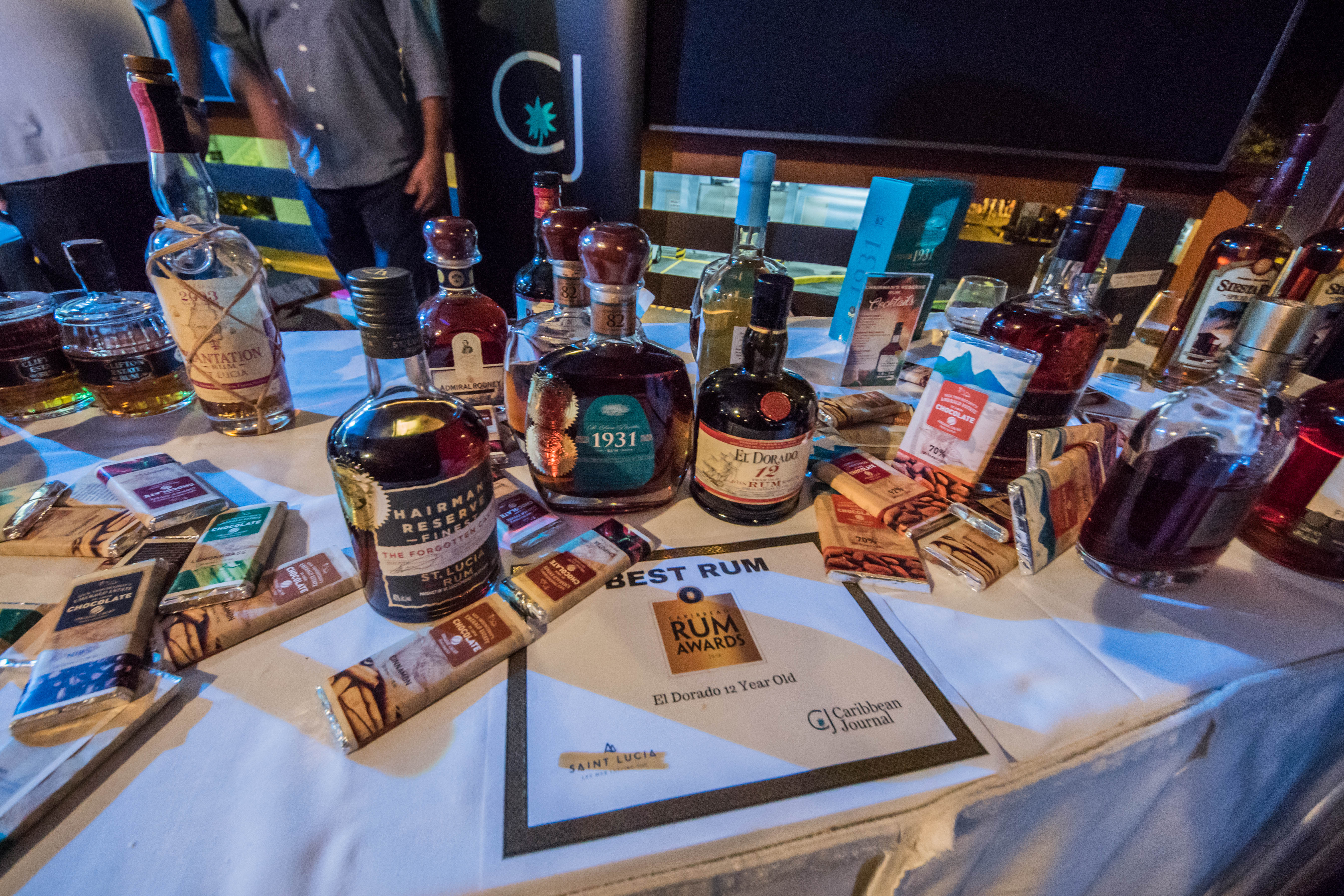
Yes, St. Lucia is the kind of place where the prime minister sidles up to you drinking rum (or rhum). Granted, “the kind of guy you could have a drink with” has long been an impression many politicians have worked hard to cultivate, usually for nefarious purposes, but rarely had I seen one prove it up close. The prime minister of St. Lucia is the kind of guy who puts a catcher’s mitt-sized paw on your shoulder while he talks and genuinely seems to be listening to what you have to say. The first thing you notice about him, after the fact that he’s white and quite large, is that he’s Canadian. Or at least, sounds Canadian. “I went to high school in Montreal,” he admitted when I asked, making me feel extra smart for noticing.
Anyway, nice guy. I’ve made a conscious effort not to look up any of his policies since, in case he turns out to be some kind of pro-slavery holocaust denier. Which would be just my luck, wouldn’t it?
After the welcome party, we made our way to a “fish fry,” in Anse la Raye, a weekly party/street festival with music, drinks, people generally making merry and having fun. Everything generally seems much more festive in the Caribbean, in part because all the music seems to have syncopated drumming and even the ballads have those reggae horns that make every word sound like the world premiere of that word. In any case, there was loud music, the smell and sizzle of street barbecue, and an emcee narrating the entire thing in the same lilting, booming baritone that gave Shaggy a career.
We spotted Marcus Samuelsson, the Ethiopian born, Sweden-raised, current Harlem resident celebrity chef wandering around. Which wasn’t difficult, seeing as he had a camera team and a clutch of gawkers and admirers following him everywhere he went. On a front porch adjacent to the street, I watched him sample what looked like sizzling salsa out of a giant rock molcajete. He nodded, squinting and furrowing his brow in appreciation, a look I imagine you have to practice when you frequently find yourself in a situation where 15 people are standing around eagerly awaiting your verdict on their food.
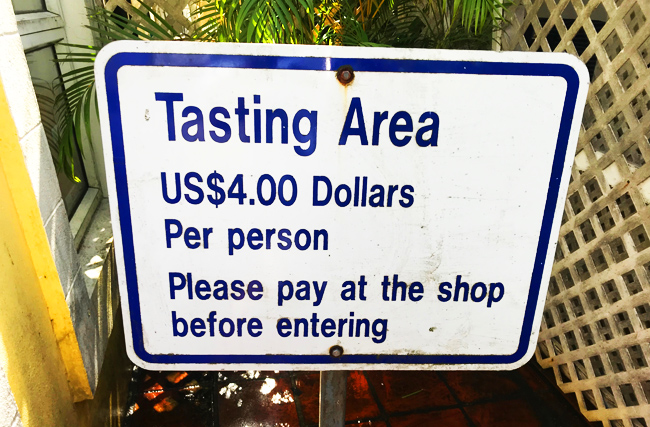
Now, I knew who Marcus Samuelsson was, as a food television junkie who has seen him guest judge everything from Chopped to Top Chef. But he’s the kind of celebrity I would have to explain to friends, more of a face you recognize than a name you recognize. I’m here to tell you: the man is huge in St. Lucia. Massive. Rarely would 10 minutes pass without the emcee praising him anew from the music tent.
“And again, special rrrround of applause to owah special guest, MISTAH! (*reggae horn*) MAH-CUS! (*reggae horn*) SAM-YOU-WEL-SAHN! (*loooooong reggae hooooorn*) Yes, big up to Mah-cus Sam-you-well-sahn, you may know him from! …Top Chef Mastahs! Chopped! and all ovah di Food Net-wahrk…” (*deafening cheers*)
This went on. Throughout the party, as we drank rum cocktails and ate road chicken, was the ever-present soundtrack of Marcus Samuelsson appreciation. Marcus Samuelsson: King of the Street Festival. In any case, it was a lovely party. I awoke the next morning with a pounding headache and a large jerk sauce stain on the front of my shirt.
Naturally, the hangover reached its zenith on the road to the St. Lucia Distillers the next day, which, like most of the roads in St. Lucia, is very winding. We’d heard that the Governor-General of St. Lucia would be attending the same dinner as us that night, which inspired a heated argument between an Indian-Jamaican journalist and a Jamaican-born St. Lucia Tourism Rep over whether Governors-General are appointed for life, or serve at the behest of the ruling party. And later over the proper dress code and ceremony required when the Governor-General attends a dinner. Was it an *official* government event? Did the Governor-General’s presence automatically make it one? Etc., etc. It would’ve been intolerably asinine had it been conducted in any different accent.
Maybe that’s an evolutionary explanation for the mellifluous island accents. They make them so pleasant sounding so that you can tolerate discussion of colonial minutiae. The same way baby animals are cute so the adults don’t eat them.
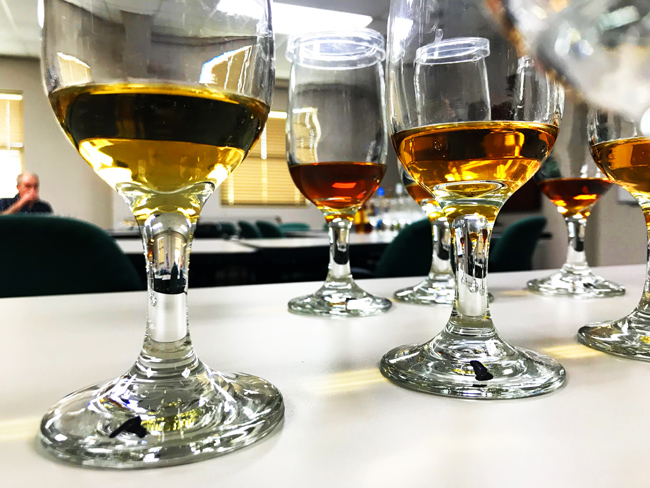
Eventually, we arrived at the distillery, a modest cluster of buildings and storage tanks with an open-walled barrel warehouse on a lonely strip of rural land tucked between some mountains and Roseau Bay (an important location — ships pump the molasses imported from Guyana 1.5 miles through an underground pipe). My head throbbed as we gathered, along with a few other tour groups, into the welcome pen area, which had a wooden replica of Jambe de Bois, complete with a parrot, who greeted us in a scratchy recorded message straight out of a Pirates of the Caribbean ride, circa 1997. Following the kitsch history lesson, there was welcome music, the most absurdly happy horns-and-steel-drum dance tune, in which the singers exhorted everyone to “dance, dance, sing, the spirit of St. Lucia, Bounty Rum.”
I wouldn’t recommend combining it with a moderate to severe hangover.
We toured the factory, examining the fermentation tanks, the three stills — two column and one pot — while our tour guide explained the various taste variations in rum created different ways. The majority of the alcohol is distilled in the column still, which he says creates “softer, rounder,” smoother rums, while the pot still are there to impart flavor. Without getting into all of the nitty gritty, the main difference between the two is that pot stills distill batch by batch while column stills can operate continuously. Also column stills can distill at a much higher alcohol content, more than 93% pure ethanol in the case of St. Lucia Distillers’. Our guide likens the product of the pot stills to a spice, “like nutmeg.”
Most of the flavor in a spirit is determined by the sugar source, and the wood flavor imparted during aging. Aside from being distilled from molasses or cane juice instead of grain, one of the main differences between rum and bourbon is that rum has fewer rules about how it can be aged. Bourbon has to come from new oak barrels; with rum they can and do use any barrel that strikes their fancy, from old bourbon oak barrels (most common) to brandy, port, red wine, etc. Each imparts a slightly different flavor. And since it’s being aged in the warm, humid Caribbean, aging happens much faster.
As I tried to take in all the #rumfacts, I was being eaten alive by aggressive mosquitos, as was everyone else on the tour. I felt like I lost a pint of blood in 20 minutes and I wanted to know how the factory workers could operate in such conditions. Sadly, it was the weekend and everyone was gone. They mercifully brought us into an administration building for a Power Point presentation and rum tasting. We tasted the pot-distilled rum (less body, less syrupy than the column still, more complex), the cherry brandy cask-aged product (my favorite), and some red wine cask-aged rum (astringent). With three stills, two yeast strains, two types of mash (molasses and cane juice), and three or four different barrel options, the possibilities for variation are endless. And exhausting. And that’s before you even get into the science of mixing (be it barrels of the same product stored in different parts of the rickhouse or barrels of different material and/or stills), or reintroducing already-aged product to new barrels (both of which St. Lucia Distillers does, for various products).
Were there flow charts? Oh my, heavens yes. Suffice it to say, my eyes glaze over at a level of complexity far lower than this. Thank God you can just drink the booze and leave the science to someone else. One of the most important things I learned that day was that bottom shelf, un-aged white rum is great for treating mosquito bites.
That night we headed off to the centerpiece dinner of the festival, catered by Marcus Samuelsson and the St. Lucia Cooking Team. I was seated next to Richmond and Austin, two guys from the tourism ministry. I told them about our street barbecue from the night before. Why, I wondered, is Marcus Samuelsson such a huge deal here?
They struggled a little to explain it, but it wasn’t their answers themselves that struck me, it was their faces when I asked. Their faces brightened. It’s one of those expressions that’s usually a meaningless cliché, but in this case it’s the only way I can describe it. It was Samuelsson’s story that resonated. Born in Ethiopia, adopted and raised in Sweden, moved to New York to make his fortune, and the youngest chef ever to receive three stars from the New York Times.
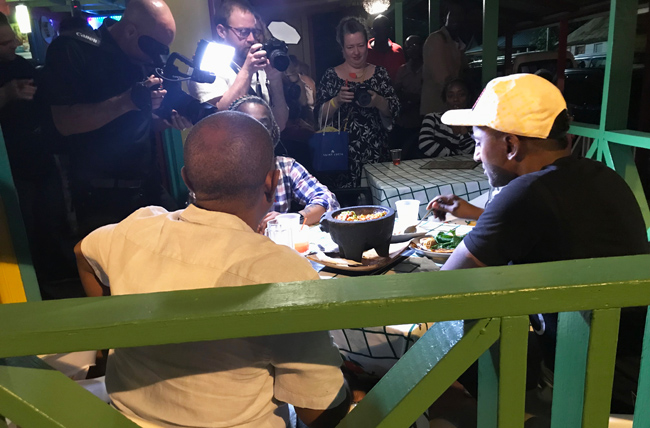
(that’s Marcus in the white hat)
Samuelsson has taken flack on occasion, with Eddie Huang accusing him of “cultural condescension” in an Observer piece a few years back. That essay also included some quotes from other prominent African American chefs like Michael Twitty, describing the “one negro syndrome” (Twitty later clarified in pro-Samuelsson terms, calling him “the culinary world’s Barack Obama.”). Most of the criticism seems to boil down to Samuelsson being overrated, or his story being overly rehashed — often in a way that helps white people feel good about themselves. I can understand being annoyed to hear Samuelsson’s origin story for the umpteenth time, or wondering why he’s constantly getting press that other deserving black chefs aren’t. And to be honest, the one or two times I’ve interviewed Samuelsson, I did find him slightly stiff. But here in the Caribbean, I gained a fuller appreciation for why that origin story gets retold so often.
The thing about the story… the story plays. At its worst, it’s a story that makes white people feel inclusive, and maybe risks becoming a token problem — why call other black chefs? We already have Marcus Samuelsson! (that seemed to be the thrust of Twitty’s concern). But here I saw the other side of it. I saw people who were legitimately inspired by the story. You could see, just in the way people talked about Samuelsson, that there’s a power in people seeing someone who looks like them succeed. And in that way, it doesn’t matter if you think Samuelsson himself is overrated, or that his mythmaking is corny. He was in St. Lucia inspiring a whole generation of chefs. Which also might explain what I interpreted as stiffness. The guy clearly spends his entire life under immense pressure, to both inspire future black chefs, and to not f*ck it up for them. The latter of which might involve a sin no greater than simply not being as great as people say you are. And how can you control what people say about you?
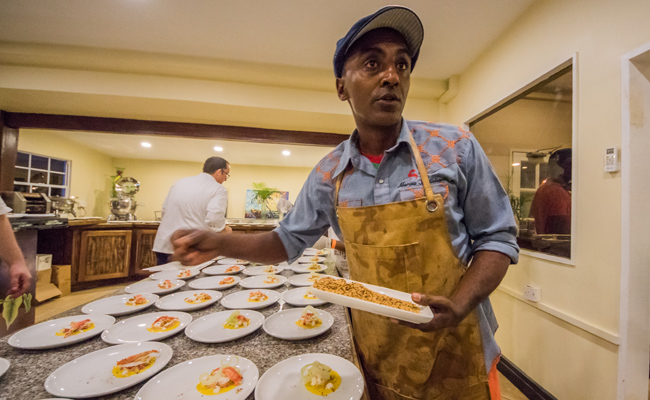
For all the criticism you hear from chefs about their colleagues who’d rather be on TV or doing events than in the kitchens of their own restaurants, on this night, Samuelsson was in the kitchen pounding plates and sweating his ass off. He didn’t come out until the end of the meal, at which point he brought out the St. Lucia cooking team, who had been the ones actually preparing the food. They basked in the attention as he introduced them one by one. Afterwards, he made the rounds, stopping briefly to chat with each table, kissing hands and shaking babies, so to speak. He seemed, once again, a little stiff. A little practiced. But… I get it now.
After dinner, we mingled. The prime minister was roaming around again (though not the Governor General). I met an expat named Alex, a tech consultant, who was tan and handsome with copious bracelets. He was St. Lucia’s biggest fan. He called it “Never Never Land.” He described the magic of it, the friendliness of the people. “You’ll open the door to a doctor’s waiting room, and everyone in the waiting room will say hello.”
I asked him about the food (I ask everyone about food). Oddly, it was the one aspect of island living about which he was circumspect. “It’s not really a food destination,” he said. “I mean, if you go to the resorts you’ll eat great food, but… it’s still a poor country. Food is more fuel.”
This seemed to contradict my jerk chicken experience from the night before, not to mention everything I thought I knew about poverty producing vibrant food cultures. Growing up in California’s central valley, some of my most memorable meals came from trucks. But who knows, maybe he was right?
I asked some of my table mates, locals who’d grown up in St. Lucia, what some of their favorite local foods were. And by that I meant the foods they missed the most when they lived abroad (which is common for people from the Caribbean pursuing post-secondary education). Richmond tells me that a lot of people here like pork, but wrinkles his nose (not a pork fan himself, apparently). Austin tells me about fish broth, a bouillon of salt fish fortified with “ground provisions.”
People here use “ground provisions” as if it’s self-explanatory, a Caribbean term that means… well, any vegetable that grows in the ground, from carrots to sweet potatoes. Our other tablemate, Agnes, brings up the fruit. Which resonates, even in my short time on the island. She mentions guava, tamarind, and fruits I’ve never even heard of, like sugar apple and golden apple, neither of which are actually apples. And of course the mango. My driver had told me there were “86 varieties of mango” grown on the island, though the number most bandied about on the internet seems to be 24. Suffice it to say, the place has a lot of mangoes.
I also learned about “green fig and salt fish,” St. Lucia’s national dish. The salt fish part is easy enough to understand, especially if you’ve ever had the Italian version, baccalá (as memorably referenced by Steve Schirripa’s Sopranos character, Bobby Baccalá, aka Bobby Baccalieri). “Green fig,” meanwhile, is actually just the local term for a green banana, usually boiled and salted, served either separate from the salt fish or mixed together, essentially functioning like a potato.
The following day, I attended the big closing day Food and Rum Festival Event at the Pigeon Island National Park. There were food booths set up around the park, centered on an amphitheater, all in the shadow of Fort Rodney, a hilltop stone fort built in the 1770s. 25 miles south of the French Fort Royal at Martinique, it was an important strategic position from the Master and Commander days, when the British and French spent their days sailing around the Caribbean, planting flags and lobbing cannonballs at each other. You can hike up the mountain and stand on top of the fort, and aside from being a great spot for a panoramic view of the island, it’s impressive that what seems like a hastily assembled pile of bricks precariously placed at the apex of a hill during a war has managed to stay standing for 200-odd years. They may not have been clever enough not to sail down to the Caribbean in itchy, unimaginably stinky wool clothes, but they clearly knew their rums and their masonry.
In the lee of the Fort, it was a beautiful humid day, with a light breeze in the verdant park. 90 minutes after the scheduled midday start time, the event was still sparsely attended, with only a handful of attendees milling about. Many of whom appeared to be British pensioners — a fascinating group of people who seem entirely out of place in the tropics, both in their safari clothes and chalky skin, yet permanently cheerful. Meanwhile, onstage, there was the ever-present Caribbean hype man, presumably a local radio personality, giving one of the most energetic and soulful emcee performances I’d ever seen, to an audience of about seven people, 30 feet away from the stage. He had a DJ sidekick (DJ Hyper D) who frequently punctuated his plugs and musings with the reggae horns. Again, no one does hype like the Caribbean.
Our emcee was presiding over a Chopped-style bartending battle, where the contestants were given a series of ingredients and challenged to include them all into a cocktail highlighting velvety smooth Admiral Rodney rum, from St. Lucia Distillers. After enthusiastically bigging up each contestant — to a smattering of half-hearted applause — he went on to introduce each ingredient of the challenge, so pumped by each that you’d think they were members of the Wu-Tang. Nor was he deterred by an unfamiliar ingredient. “An’ ‘ere we ‘ave da… CHINESE STAR!” he boomed, holding up a pod of star anise. “To be honest I am not too fah-mil-yahr wit dis one, but I’m shahr dese fine gen-tall-man will know what to do wit it. (*reggae horn*)”
To see him riff, never betraying an ounce of fluster, was to be inspired. Often he’d punctuate his statements with “HYPAH!” his cue for DJ Hyper D to play him off, usually with some absurdly cheerful cacaphony of calypso-dancehall-reggae horn fusion, all with that “Hot Hot Hot” vibe. One song was called, and I will swear to this, “All Inclusive.” Its lyrics celebrated a very specific situation, the singer scatting “I have a drink in me hand, I want da next one (BUH! BUH!)/So give me da bucket, I have me wrist band (BUH! BUH!)”
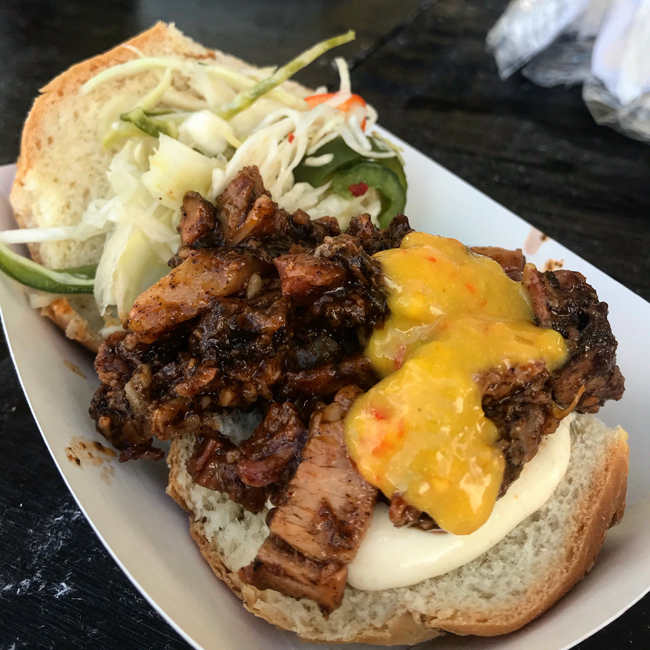
The upside of the light crowd was no lines at the food stalls, giving me a chance to sample all of their wares. Most of the stalls were from resorts, so I had no way of refuting Alex from the night before. Nonetheless, they seemed to be cooking local dishes that weren’t gussied up beyond all recognition. There was a roasted pork shoulder in jerk seasoning, slathered in a scotch bonnet hot sauce so good I came back to ask “Do you guys sell this?”
“It’s Baron’s,” the slightly gruff, bald white chef told me. “You can get it at any supermarket.”
Ah, Baron West Indian Hot Sauce, of course. Indeed, I later bought some at the airport. Not exactly… artisanal, but tasty nonetheless. And new to me.
I ate numerous conch fritters, all delicious. A lobster salad served in a fry-bread bun. Why aren’t there more fry bread buns? There were toast points with chicken pate in between, topped with a red pepper relish and served atop a puddle of jerk sauce. Strange presentation, that, but it was so good I had two. Eventually, I worked up the courage to try the fish bouillon, figuring I had to after hearing that it was a local’s number one childhood favorite. I eat everything now, but growing up I did have an aversion to fish. My parents’ favorite food was broiled salmon, and nothing stinks up an entire house like a broiled salmon. Ugh, I can still smell it. Even now I never order salmon unless it’s raw.
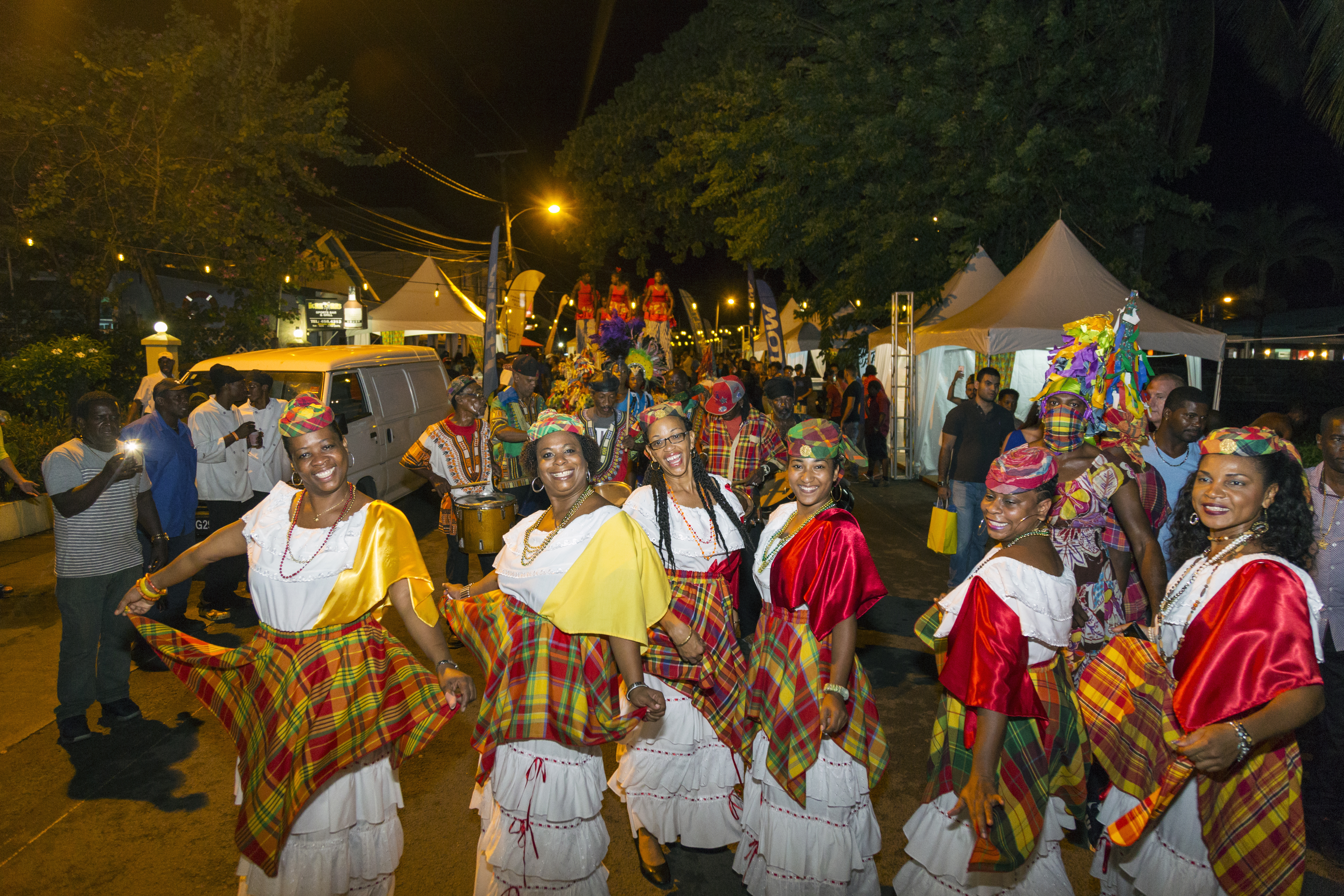
In any case, this surely fancied-up version of fish bouillon was billed as “Chairman’s spiced salt fish bouillon lifted with starch fried okra and coconut rum infused green banana.”
The lack of commas made it difficult, but I think it was something like bouillon, “lifted” with starch, accompanied by fried okra and rum-infused green banana — aka, a variation on “salt fish and green fig.” It wasn’t at all what I was expecting. It didn’t taste fishy at all, and the texture and flavor reminded me of dal, Indian lentils. And probably not accidental, considering the Caribbean’s heavy Indian influence. It’s the legacy of Indians who emigrated or were brought to the islands as indentured servants by the British in the 19th century. An Indian influence really does wonders for a food culture. It was easy to see why salt fish and green figs were a comfort food. It was sort of like gumbo, or pork and beans.
I took a walk up the hill to the fort as a food breather, and when I came back down the locals were finally beginning to trickle in. “Island time” is a real thing. The vibe had palpably shifted, from curious upright Brits to comfortable locals meeting friends. Voices were louder. The music was… the same volume, but now people were listening to it. There was dancing. I walked past a guy behind a food table, swaying to the music while manning a hot grill covered in some buttery, garlicky, seafood.
“What’s that?” I shouted at him.
“It’s conch,” he shouted back, once I’d gotten his attention. “Wanna try?” he asked, to which I nodded eagerly.
He jabbed a morsel of buttery, lightly charred conch with his long fork and handed it to me, and I immediately shoved in my mouth as fast as I could before checking to see if it was hot first. In that moment, I experienced pure joy. There’s nothing like char-grilled food on a perfect sunny day.
Meanwhile, The Carribean Journal announced the winners of their first-ever Caribbean rum awards:
White Rum
Best White Rum: Doorly’s Macaw (Barbados)
Double Gold: Bounty Premium White Rum (Saint Lucia)
Gold: Brugal Special Extra Dry (Dominican Republic)
Best Rum
Best Rum: El Dorado 12 (Guyana)
Double Gold: 1931 by St Lucia Distillers (Saint Lucia)
Gold: Chairman’s Reserve The Forgotten Casks (Saint Lucia)
Best White Rhum Agricole
Best: Rhum Neisson Bio 52.5 (Martinique)
Double Gold: Rhum Dillon Ti’ Fle’ Ble’ (Martinique)
Gold: Rhum Clement Canne Bleue (Martinique)
Best Rhum Agricole
Best: Rhum JM VO
Double Gold: Rhum Depaz XO
Gold: Rhum Clement 10 Ans
Best Spiced Rum
Best: Siesta Key Spiced Rum (Florida)
Double Gold: Chairman’s Reserve Spiced Rum (Saint Lucia)
Gold: Clifton Estate Rum (Nevis)
Best Gold Rum
Best: Bounty Premium Gold (Saint Lucia)
Double Gold: Island Company Rum (Trinidad)
Gold: Siesta Key Gold (Florida)
I don’t know why you’d ever drink a white (unaged) rum, and spiced rum just gives me bad flashbacks to high school, and chugging Malibu. “Gold Rum” refers in this case to “mildly aged,” product. It isn’t nearly as smooth as the more aged products, and my tasting notes for the Bounty Gold were “you know you’re drinking straight rum.” Probably better as a mixer. I’d never drink straight gin, but it makes the best mixer. Try a bloody Mary with gin. You’ll never go back.
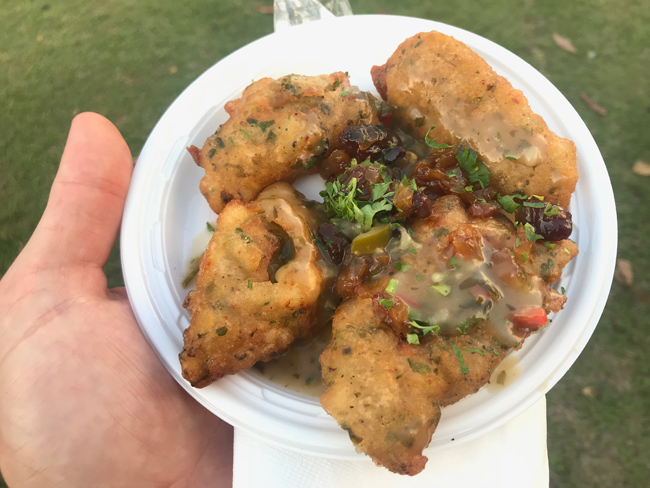
The El Dorado, 1931, and Forgotten Cask were all superb. All were smooth and molassesy, able to be savored neat. The 1931 has a strong vanilla note, and ended up winning the audience award. Pappy Van Winkle also has a strong vanilla character to it — when it comes to liquor, vanilla works. The rhums agricole… still a little too complicated for me, but I can understand why it’s the drink of choice for tropical sophisticates like the Prime Minister. It seems like the sour beer equivalent of rum. “I don’t know when or where I would choose this over the regular version, but it’s certainly… interesting.”
The evening wound down with a concert by Freddie Jackson, an old school R&B legend. He gave roses to women in the audience, vamped around the stage, and had a dedicated band member whose job it was to place and remove Freddie’s coat on his shoulders. The crowd ate it up — the old pro, doing the old-fashioned showmanship. He reminded me of Sexual Chocolate, from Coming to America.
There are few feelings more bittersweet than your last few hours in a tropical paradise before you board a plane back to your real life in the middle of winter. For my last meal, I walked down the steps to the Naked Fisherman, an open-air restaurant in a private cove just down the way from the Cap Maison hotel — on the recommendation from the rum guy, Guy Britton. I had a grilled Mahi (normally what I’d consider one of the most boring fishes, a sort of skinless chicken breast of the sea) with another pepper relish and some greens and pumpkin curry served on the side. Naturally, it was the best thing I ate all week.
Do you have to fly halfway around the world to eat nice fish or drink fine Caribbean rum? Of course not. But once you’ve done it, experienced the thing under ideal circumstances, like a torchlit beach or a private cove, you’ll have that sense memory forever. And all it takes is a little rum or the smell of a stew to bring it rushing back. So maybe an “escape” or a “getaway” is the wrong word for it. Maybe it’s less about what you escape than the experiences you carry home.






